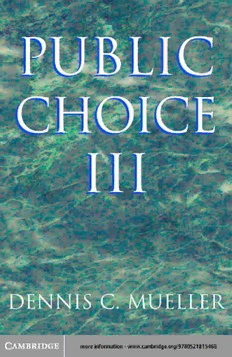
Public choice III PDF
Preview Public choice III
This page intentionally left blank PublicChoiceIII This book represents a considerable revision and expansion of Public Choice II (1989).Sixnewchaptershavebeenadded,andseveralchaptersfromtheprevious editionhavebeenextensivelyrevised.Thediscussionofempiricalworkinpublic choicehasbeengreatlyexpanded.Asinthepreviouseditions,allthemajortopics of public choice are covered. These include why the state exists, voting rules, federalism, the theory of clubs, two-party and multiparty electoral systems, rent seeking,bureaucracy,interestgroups,dictatorship,thesizeofgovernment,voter participation, and political business cycles. Normative issues in public choice are also examined, including a normative analysis of the simple majority rule, Bergson–Samuelson social welfare functions, the Arrow and Sen impossibility theorems,Rawls’ssocialcontracttheory,andtheconstitutionalpoliticaleconomy ofBuchananandTullock. Dennis C. Mueller is Professor of Economics at the University of Vienna. He previously taught for many years at the University of Maryland. Professor MuelleristheauthorofPublicChoiceII,ProfitsintheLongRun,Constitutional Democracy, and four other books, in addition to numerous articles in leading refereedjournals.Heisalsotheeditorofthetwo-volumeTheEconomicsofPolitics (2001), Perspectives on Public Choice (Cambridge University Press, 1997), and The Dynamics of Company Profits (Cambridge University Press, 1990), as well as six other titles. Professor Mueller is a past president of the Public Choice Society,theSouthernEconomicAssociation,theIndustrialOrganizationSociety, andEARIE.Hismainresearchinterestscontinuetobeinpublicchoiceandindus- trialeconomics. Public Choice III DENNIS C. MUELLER UniversityofVienna Cambridge, New York, Melbourne, Madrid, Cape Town, Singapore, São Paulo Cambridge University Press The Edinburgh Building, Cambridge , United Kingdom Published in the United States of America by Cambridge University Press, New York www.cambridge.org Information on this title: www.cambridge.org/9780521815468 © Dennis C. Mueller 2003 This book is in copyright. Subject to statutory exception and to the provision of relevant collective licensing agreements, no reproduction of any part may take place without the written permission of Cambridge University Press. First published in print format 2003 - isbn-13 978-0-511-07350-2 eBook (EBL) - isbn-10 0-511-07350-X eBook (EBL) - isbn-13 978-0-521-81546-8 hardback - isbn-10 0-521-81546-0 hardback isbn--13 978-0-521-89475-3 paperback - isbn-10 0-521-89475-1 paperback Cambridge University Press has no responsibility for the persistence or accuracy of s for external or third-party internet websites referred to in this book, and does not guarantee that any content on such websites is, or will remain, accurate or appropriate. ToAdrienne,Holly,Jacob,andLaurence Contents Preface pagexvii 1 Introduction 1 PartI Originsofthestate 2 Thereasonforcollectivechoice–allocativeefficiency 9 2.1 Publicgoodsandprisoners’dilemmas 9 2.2 Coordinationgames 14 2.3 Publicgoodsandchickens 16 2.4* Voluntaryprovisionofpublicgoodswithconstantreturnstoscale 18 2.5* Voluntaryprovisionofpublicgoodswithvaryingsupplytechnologies 22 2.6 Externalities 25 2.7 TheCoasetheorem 27 2.8 Coaseandthecore 30 2.9 AgeneralizationoftheCoasetheorem 32 2.10 DoestheCoasetheoremholdwithoutpredefinedpropertyrights? 34 2.11 Externalitieswithlargenumbersofindividuals 35 2.12 Externalitieswithlargenumbersofindividuals–asecondtime 39 2.13 Experimentalresultsinthevoluntaryprovisionofpublicgoods 40 3 Thereasonforcollectivechoice–redistribution 44 3.1 Redistributionasinsurance 45 3.2 Redistributionasapublicgood 47 3.3 Redistributiontosatisfyfairnessnorms 49 3.4 Redistributiontoimproveallocativeefficiency 51 3.5 Redistributionastaking 53 3.6 IncometransfersintheUnitedStates 56 3.7 Redistributionandthedistributionofincome 58 3.8 Redistributiontospecialinterests 61 PartII Publicchoiceinadirectdemocracy 4 Thechoiceofvotingrule 67 4.1 Theunanimityrule 67 4.2 Criticismsoftheunanimityrule 72 4.3 Theoptimalmajority 74 4.4 Asimplemajorityastheoptimalmajority 76 vii viii Contents 5 Majorityrule–positiveproperties 79 5.1 Majorityruleandredistribution 79 5.2 Cycling 84 5.3* Themedianvotertheorem–one-dimensionalissues 85 5.4 Majorityruleandmultidimensionalissues 87 5.5* Proofofthemedianvotertheorem–multidimensionalcase 92 5.6 Majorityruleequilibriawhenpreferencesarenotdefinedin spatialterms 94 5.7* Proofofextremalrestriction–majorityruletheorem 95 5.8 Restrictions on preferences, on the nature and number of issues, and onthechoiceofvotingrulethatcaninduceequilibria 97 5.8.1 Preferencehomogeneity 97 5.8.2 Homogeneouspreferencesandqualifiedmajorityrules 99 5.8.3 Therelationshipbetweennumbersofissuesandalternatives andtherequiredmajority 103 5.9 Logrolling 104 5.10* Logrollingandcycling 108 5.11 Testingforlogrolling 109 5.12 Agendamanipulation 112 5.12.1 Agendacontrolinaspatialenvironment 112 5.12.2 Agendacontrolinadivide-the-cakegame 113 5.13 Whysomuchstability? 114 5.13.1 Issuesareindeedofonedimension 115 5.13.2 Votingonedimensionatatime 116 5.13.3 Logrollingequilibria 118 5.13.4 Empiricalevidenceofcycling 120 5.13.5 Experimentalevidenceofcycling 123 6 Majorityrule–normativeproperties 128 6.1 Condorcet’sjurytheorem 128 6.2 May’stheoremonmajorityrule 133 6.3* ProofofMay’stheoremonmajorityrule 135 6.4 TheRae-Taylortheoremonmajorityrule 136 6.5 Assumptionsunderlyingtheunanimityrule 137 6.6 Assumptionsunderlyingthetworulescontrasted 138 6.7 Theconsequencesofapplyingtherulestothe“wrong”issues 140 6.7.1 Decidingimprovementsinallocativeefficiencyviamajorityrule 140 6.7.2 Decidingredistributionbyunanimity 143 6.8 Conclusions 144 7 Simplealternativestomajorityrule 147 7.1 Thealternativevotingproceduresdefined 147 7.2 Theprocedurescompared–Condorcetefficiency 148 7.3 Theprocedurescompared–utilitarianefficiency 151 7.4 TheBordacount 152 7.4.1 Axiomaticproperties 152 7.4.2 TheBordacountandthe“tyrannyofthemajority” 154 7.4.3 TheBordacountandstrategicmanipulation 155 7.5 Approvalvoting 156 7.6 Implicationsforelectoralreform 157
